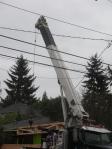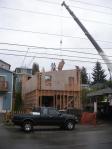I find it interesting when in the course of a few weeks a topic keeps coming up in different conversations so often that the number of occurrences catch your attention. Just this week I have heard several people discuss Passive House as it relates to other areas of Sustainable Construction. Since this is a blog whose main focus began with the idea of using Existing Resources and is also promoting Passive House construction, I wanted to broaden the discussion to show how these two goals work very well together.
I have heard a few comments that Passive House does not promote “green building” as a focus of a project. By this the commenter usually is referring to material selection, or reuse of materials already on site. While the Passive House requirements do not specifically have a mandate or credit for a percentage of reused or recycled materials brought from a close proximity, that discussion is very much alive in the Passive House Consultant community.
Passive House began as a way to reduce the ever-increasing need for fossil fuels. It approaches the carbon footprint argument from a different direction than the embodied energy of Existing Resources does. Passive House construction does this specifically by reducing what is needed to heat and power a building over the lifetime of that structure and thus requires less energy to be produced at the global level. By developing methods to bring Passive House construction to retrofits AND require they have the same performance of newly constructed Passive House buildings, the Existing Resources that are already in place in the present day building stock and their embodied energy can be incorporated into the main goal that Passive House construction has of reducing energy requirements while also promoting sustainable building practices.
While Passive House does not focus specifically on which materials can be reused and what building methods best promote sustainable construction, the people who are involved in the effort to bring Passive House construction to the forefront are keenly aware of these issues and do take steps to incorporate them into their projects. Passive House Northwest has a mission statement that says in part “We are motivated by the long-term protection of the environment and climate; the promotion of sustainability, quality, and durability in building construction; the creation of a built environment that is healthy for its inhabitants; and the advancement of energy independence and the reduction of operating costs for building occupants and owners.” Many of the Passive House consultants from Seattle are also members of the Ec0-Building Guild. I am certain that other consultants from different areas of the country have similar associations.
Just as there is no one way to build a Passive House, there is also no one way to build Sustainably. It is the overall impact that remains as the goal and reusing materials, or putting them out to be reused by others fits the underlying principle of Passive House very well – if something is already made, the energy to make another one does not have to be provided. Existing Resources can help Passive House achieve their goal, it is up to the building professionals and others in the local community to find the ways this can happen easily, efficiently, and affordably for all concerned.
The conversation of the role Existing Resources play in Passive House is ongoing, as is another conversation of taking Passive House to Net Zero through adding alternate energy sources to a project specifically to reach this goal. It is good to have these conversations, share ideas and opinions, solve problems, and address misconceptions should they arise. The good news is that you do not have to pick Passive House over Sustainable Construction – Passive House IS Sustainable Construction, how sustainable is up to those involved with the project and the resources available.
-Linda
Read More










Recent Comments